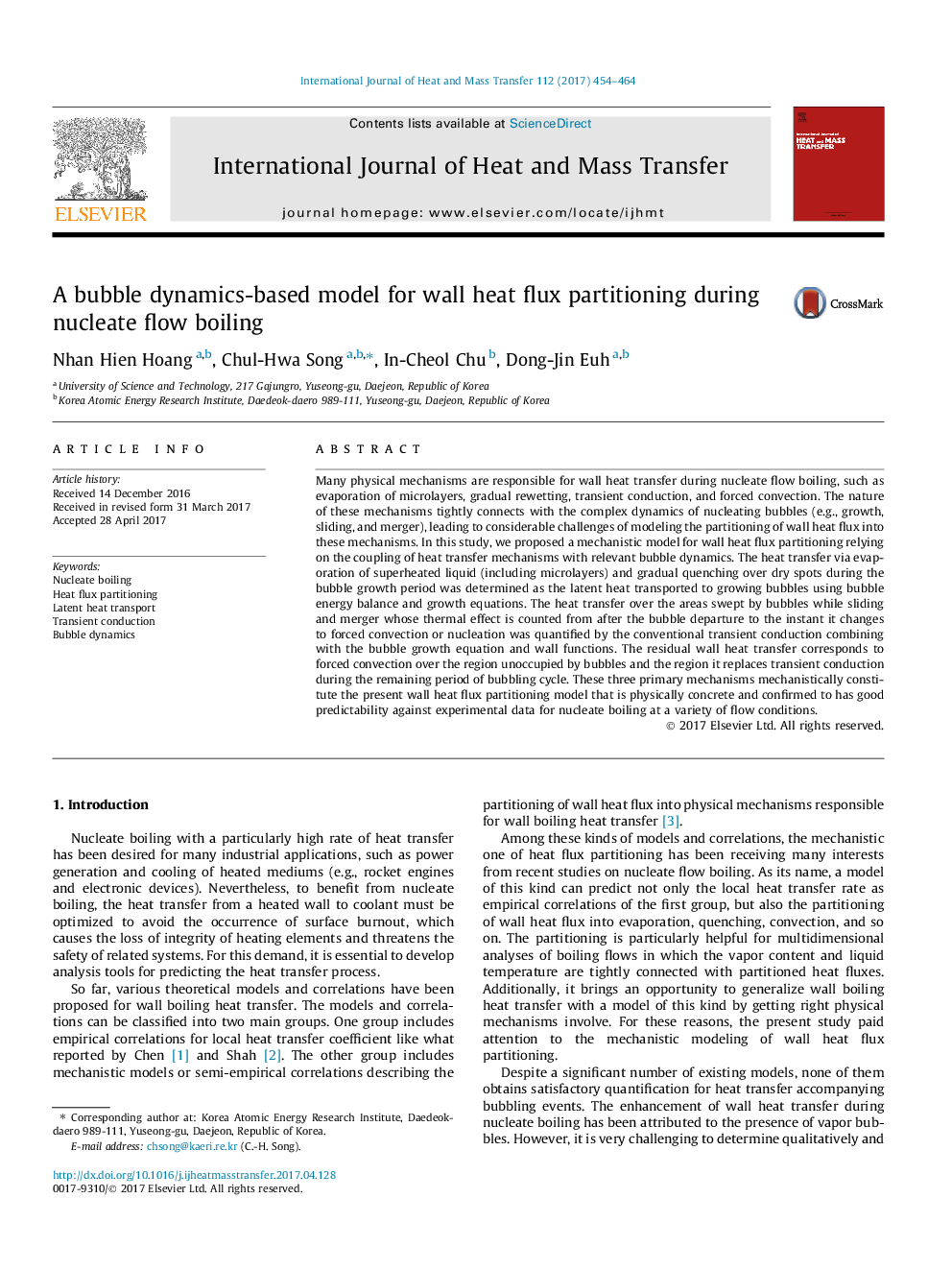| کد مقاله | کد نشریه | سال انتشار | مقاله انگلیسی | نسخه تمام متن |
|---|---|---|---|---|
| 4993672 | 1458029 | 2017 | 11 صفحه PDF | دانلود رایگان |
عنوان انگلیسی مقاله ISI
A bubble dynamics-based model for wall heat flux partitioning during nucleate flow boiling
ترجمه فارسی عنوان
یک مدل مبتنی بر پویایی حباب برای پارتیشن بندی جریان حرارت دیواره در طی جوشیدن جریان جیوه
دانلود مقاله + سفارش ترجمه
دانلود مقاله ISI انگلیسی
رایگان برای ایرانیان
کلمات کلیدی
جوشیدن هسته، پراکندگی جریان شار حرارت، انتقال گرما خفیف، هدایت گذرا، دینامیک حباب،
ترجمه چکیده
بسیاری از مکانیزم های فیزیکی مسئول انتقال گرمادهی دیواره در طی جوشیدن جریان های هسته ای هستند، مانند تبخیر میکرولیترها، رطوبت تدریجی، هدایت گذرا و انجماد اجباری. ماهیت این مکانیزم ها به شدت با دینامیک پیچیده ای از حباب های هسته ای ارتباط دارد (به عنوان مثال، رشد، کشویی و ادغام)، و منجر به چالش های قابل توجهی در مدل سازی پراکندگی شار گرمادی دیوار به این سازوکارها می شود. در این مطالعه ما یک مدل مکانیستی برای پراکندگی جریان شار دیوار پیشنهاد کردیم که متکی بر مکانیزم انتقال حرارت با دینامیک حباب مربوطه است. انتقال گرما از طریق تبخیر مایع سوپر تبخیر (از جمله میکرولیترها) و خنک شدن تدریجی در نقاط خشک در طی دوره رشد حباب به عنوان گرمای پنهان به حباب های در حال رشد منتقل شد و با استفاده از تعادل انرژی حباب و معادلات رشد تعیین شد. انتقال گرما در حوزه های حباب در حالی که کشویی و ادغام که اثر حرارتی آن پس از خروج حباب به لحظه ای که آن را به کنجکاوی اجباری یا خنثی سازی تغییر می دهد، محاسبه شده است با هدایت متداول گذار متعارف همراه با معادله رشد حباب و عملکرد دیوار، اندازه گیری شده است. انتقال حرارت دیواره باقی مانده مربوط به ترانسفورماتور اجباری در منطقه است که در آن حباب ها نداشتند و منطقه آن را در طول دوره باقی مانده از چرخه حباب جایگزین هدایت گذرا می کند. این سه مکانیسم اولیه به صورت مکانیکی شکلدهنده مدل پارتیشن بندی جریان گرمادهی دیوار است که به لحاظ فیزیکی بتن مسلح است و تاکید دارد که پیش بینی خوبی در مقایسه با داده های تجربی برای جوشیدن هسته در شرایط مختلف جریان دارد.
موضوعات مرتبط
مهندسی و علوم پایه
مهندسی شیمی
جریان سیال و فرایندهای انتقال
چکیده انگلیسی
Many physical mechanisms are responsible for wall heat transfer during nucleate flow boiling, such as evaporation of microlayers, gradual rewetting, transient conduction, and forced convection. The nature of these mechanisms tightly connects with the complex dynamics of nucleating bubbles (e.g., growth, sliding, and merger), leading to considerable challenges of modeling the partitioning of wall heat flux into these mechanisms. In this study, we proposed a mechanistic model for wall heat flux partitioning relying on the coupling of heat transfer mechanisms with relevant bubble dynamics. The heat transfer via evaporation of superheated liquid (including microlayers) and gradual quenching over dry spots during the bubble growth period was determined as the latent heat transported to growing bubbles using bubble energy balance and growth equations. The heat transfer over the areas swept by bubbles while sliding and merger whose thermal effect is counted from after the bubble departure to the instant it changes to forced convection or nucleation was quantified by the conventional transient conduction combining with the bubble growth equation and wall functions. The residual wall heat transfer corresponds to forced convection over the region unoccupied by bubbles and the region it replaces transient conduction during the remaining period of bubbling cycle. These three primary mechanisms mechanistically constitute the present wall heat flux partitioning model that is physically concrete and confirmed to has good predictability against experimental data for nucleate boiling at a variety of flow conditions.
ناشر
Database: Elsevier - ScienceDirect (ساینس دایرکت)
Journal: International Journal of Heat and Mass Transfer - Volume 112, September 2017, Pages 454-464
Journal: International Journal of Heat and Mass Transfer - Volume 112, September 2017, Pages 454-464
نویسندگان
Nhan Hien Hoang, Chul-Hwa Song, In-Cheol Chu, Dong-Jin Euh,
